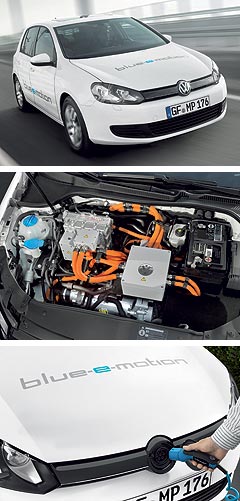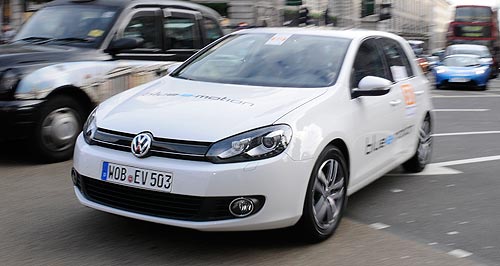Future models - Volkswagen - Golf - E-MotionVW confirms electric GolfE-Motional rescue: Volkswagen will use the zero-emissions Golf and other new models to get back into the EV game from 2013. Golf Blue-E-Motion wins eco challenge as series production scheduled for late 201315 Nov 2010 VOLKSWAGEN will start selling its zero-emissions electric-powered Golf globally in late 2013, soon after the German car-maker introduces its first dedicated electric model, the Up city-car. The Volkswagen Golf Blue-E-Motion – an electric-only variant of the next-generation version of the third-best-selling car in history – made headlines in Britain last week when it won the second ‘Future Car Challenge’, a 92km economy drive from Brighton to London. A prototype Golf EV, which makes its motor show debut in Los Angeles later this week, beat more than 60 entrants with an overall consumption figure of 11.35kWh (kilowatt hours) – deemed the equivalent of emitting 67g/km of carbon dioxide by the UK Carbon Trust. Although a small event in world terms, the victory comes as a fillip for the German car industry, which has copped some criticism for being late joining the electric car movement compared with other countries.  VW has responded to that criticism by reminding the world of its long-forgotten Golf CityStrommer programs, which put a couple of hundred underpowered (20kW), slow (0-50km/h in 13.0 seconds) and short-range (50km) all-electric Golfs into select fleets between 1986 and 1996. VW has responded to that criticism by reminding the world of its long-forgotten Golf CityStrommer programs, which put a couple of hundred underpowered (20kW), slow (0-50km/h in 13.0 seconds) and short-range (50km) all-electric Golfs into select fleets between 1986 and 1996.In addition to a domestic program to put one million EVs on the road by 2020, the German car-makers have undoubtedly been motivated by a strong push by the Chinese government to introduce electric cars and renewable energy in what is now the world’s largest vehicle market. VW has plans to sell 10,000 electric cars in China between 2014 and 2018. As well as introducing the Golf Blue-E-Motion hatch and Blue-E-Motion versions of the closely related Jetta and Chinese-market Lavida sedans, Volkswagen Group China president Karl-Thomas Neumann said last week that the company would produce an electric model specifically developed for China in 2018. China is offering attractive subsidies of up to 60,000 yuan ($A9150) to buyers of pure electric vehicles in five cities – Shanghai, Shenzhen, Hangzhou, Hefei and Changchun – under a pilot program. In prototype form, the Volkswagen Golf Blue-E-Motion has a potent lithium-ion battery pack with an energy capacity of 26.5kWh, providing a range of up to 150km, but the company does not quote recharging times. In a statement issued ahead of the LA show, Volkswagen said it will announce final driving range data at launch, but expects it “to be significantly improved with the battery technology used then”. In the meantime, it argues that the vast majority of city commuters travel less than 150km a day. Importantly – at least for the German market – the Golf EV has a top speed of 135km/h (compared to 100km/h for the old CityStrommer) and can accelerate from 0-100km/h in 11.8 seconds, thanks in part to a low aerodynamic drag figure of 0.295Cd. Located in place of the regular engine and still driving the front wheels, the single electric motor produces 85kW of power and 270Nm of torque, delivered via a single-speed transmission. The battery pack consists of 180 lithium-ion cells in 30 modules located around the vehicle – under the floor of the reduced 279-litre boot, under the rear seat and in the centre tunnel of the underbody between the front seats – with a cooling system to prevent overheating. Although the battery modules weigh in at 315kg, the five-door Golf Blue-E-Motion is only 205kg heavier than a comparable Golf BlueMotion turbo-diesel with a DSG dual-clutch transmission. The charge plug is located at the front of the Golf behind the VW grille badge. One of the key technical features of the Golf Blue-E-Motion is a four-stage braking energy recovery strategy, which can be selected via an automatic gearshift lever or the gearshift stalk on the steering wheel. In the lowest stage (D), the car “sails” as soon as the driver’s foot leaves the accelerator pedal, with the motor controlled to the zero-torque curve, allowing the car to coast down the road with the least possible drag, slowed only by the rolling resistance of the tyres and air resistance. In the D3 stage, the maximum amount of kinetic energy is recovered and fed to the battery. An active driving profile can also be set, allowing the driver to select between maximum range, maximum comfort and maximum dynamics in advance. The selected profile then pre-configures the power of the electric motor, air-conditioning control, maximum speed and battery regeneration strategy. The level of regeneration intensity is shown on a multi-function display located in front of the driver between the kW gauge (which replaces the tachometer) and the speedometer. The instrument binnacle also includes a battery charge indicator gauge and a range indicator. In addition, the electrical energy consumption of the automatic climate-control system and its blower is shown in the multi-function display.  Read moreGolf pricing
Motor industry news |
Click to shareVolkswagen modelsGolf pricing
Motor industry news |















Facebook Twitter Instagram